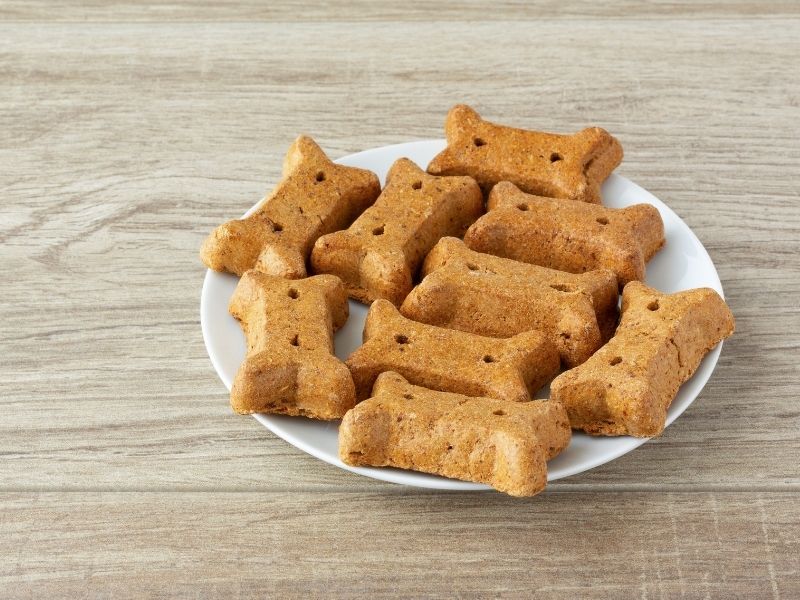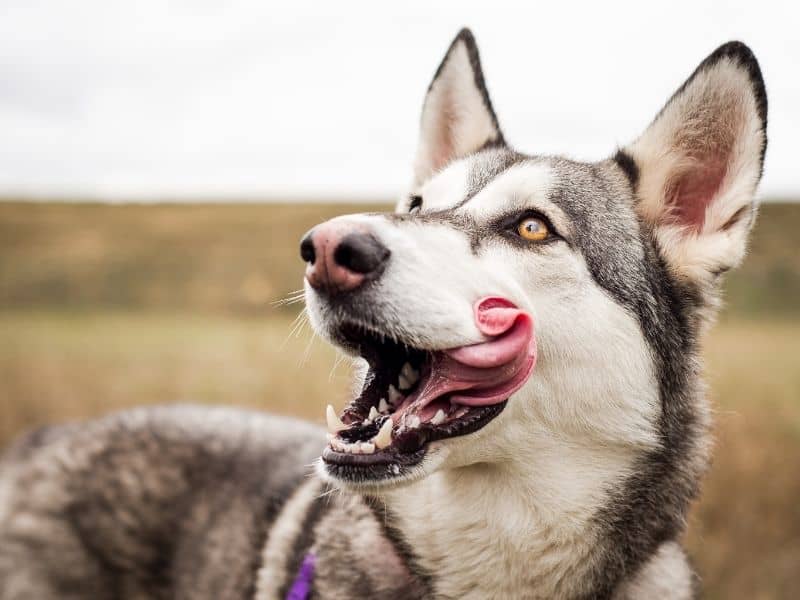Who doesn’t love peanut butter? If you open the jar and all of a sudden you have a pair of husky eyes staring up at you, you’re not alone. Huskies and other dogs can’t seem to resist the smell of peanut butter, but can huskies eat peanut butter?
Yes, your husky can eat peanut butter as long as it is given in moderation and doesn’t contain xylitol, which is toxic to dogs. Check that label in the supermarket and if it doesn’t contain xylitol, you can use Peanut butter as a really tasty treat for your pup.
- How much peanut butter can huskies eat?
- How to feed peanut butter to your husky
- What brand of peanut butter is safe for dogs?
- Can I give my husky Bega peanut butter?
- Can huskies eat peanut butter and jelly?
- Can huskies eat peanut butter cookies?
- Can husky puppies eat peanut butter?
- Are huskies allergic to peanut butter?
- Final thoughts on huskies eating peanut butter
How much peanut butter can huskies eat?
Peanut butter contains plenty of natural fats and protein, if your husky eats too much peanut butter, it can lead to obesity and other health complications like pancreatitis.
Peanut butter should never be used as a meal replacement and should rather be used as a treat for your dog in moderation.
Generally speaking, you can follow the 10% rule, which is a simple rule that states that dog treats shouldn’t make up more than 10% of the food your husky gets on a daily basis.
How to feed peanut butter to your husky
There are plenty of ways you can feed your husky peanut butter.
The simplest could be to simply let them lick it out of a spoon, or you could get your baking hat out and make some delicious peanut butter dog treats for your husky.
Peanut butter can also be a great way to give your husky meds if they’re not cooperating. Just cover the pill in a teaspoon of peanut butter and give it to them.
If you want to entertain your husky for hours, put a tablespoon of peanut butter onto some treats and then put it into a Kong or a similar treat holding toy. If your husky is anything like ours, they’ll be occupied for hours trying to lick the peanut butter out.

What brand of peanut butter is safe for dogs?
The most popular brands of peanut butter, such as Jif, Skippy, Smuckers, and Peter Pan are all xylitol-free. Many brands are safe for your husky, but make sure to always check the ingredients before giving them to your husky.
It may be that a previous brand that once was safe has decided to cut some corners and use the artificial sweetener xylitol in their peanut butter.
Also, check to make sure there is no chocolate in the peanut butter or that you’re not purchasing chocolate-flavored peanut butter.
According to Preventative Vet, the following brands of peanut butter are NOT SAFE for your dog as they contain Xylitol: Go Nuts, Co., Krush Nutrition (appears to no longer be in production), Nuts ‘N More, P28.
Stay away from these brands, but still, check the label!
Can I give my husky Bega peanut butter?
Bega peanut butter only contains peanuts, vegetable oil, sugar, and salt. With no chocolate or xylitol in the original recipe, Bega peanut butter is a safe snack for your husky and other dogs.
This is at the time of writing, however, always check to make sure they haven’t changed their recipe or you’re not purchasing a different type of peanut butter that may contain unhealthy ingredients for your husky.

Can huskies eat peanut butter and jelly?
Peanut butter is perfectly fine (if it doesn’t contain chocolate or xylitol) but you should not give your husky any jelly.
Jellies contain a lot of sugar and preservatives which can be very unhealthy for your husky and other dogs. Jelly can also contain the toxic xylitol.
If you want to give your husky a tasty treat, stick to peanut butter, or try some fruits like apples or bananas.
Can huskies eat peanut butter cookies?
Peanut butter cookies are a delicious snack for us humans, but often what makes them tasty for us can mean they are not very healthy for our pets.
Huskies can generally eat peanut butter cookies, especially homemade peanut butter dog biscuits, but the peanut butter cookies we tend to eat contain a lot of sugar which is not healthy for dogs.
Peanut butter cookies can also sometimes contain chocolate or xylitol, which should never be given to your dog.
If you want to give your husky a tasty peanut butter cookie, stay on the safe side and make them yourself following a recipe like this.
Can husky puppies eat peanut butter?
Yes, even husky puppies can eat peanut butter.
Make sure to give it to them in moderation though and use it as a treat or as a way to get them to take some medication that they may not be too interested in.
Are huskies allergic to peanut butter?
While peanut butter is generally safe for most huskies to eat, some may have peanut allergies.
Like with all new foods, you should give your husky it in phases starting small.
Some signs of allergic behavior include gastric distress, skin irritation, or hair loss (not to be confused with shedding).
If your husky shows any of these signs, you should contact your vet immediately.
Final thoughts on huskies eating peanut butter
Peanut butter is a great snack to give to your husky in moderation, but it’s always best to check the ingredients to make sure it doesn’t contain chocolate or xylitol.
Avoid sugary additions like jelly or store-bought peanut butter cookies, instead, bake some peanut butter dog biscuits, or put a spoonful into a Kong and watch your husky entertain themselves for hours.



